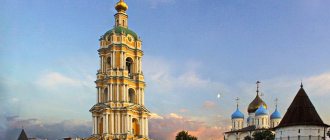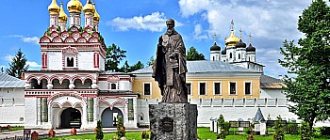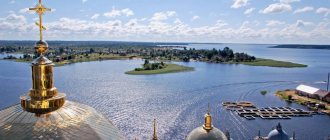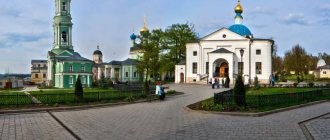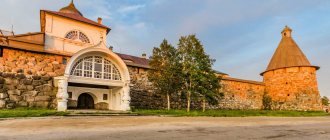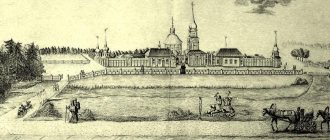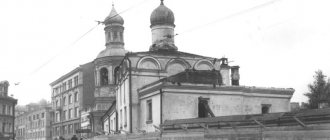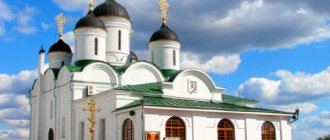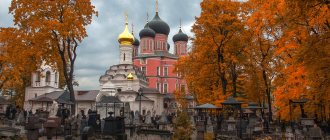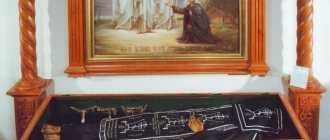Optina Pustyn is located several miles from Kozelsk, Kaluga province. It is located on the banks of the fast river Zhizdra, cutting it off from the rest of the world, and is surrounded by virgin forest. The Optina Monastery is a majestic white Kremlin with 4 temples, fortress walls and towers.
Optina’s high spiritual life is in harmony with her external beauty.
After visiting Optina, Gogol describes its exceptional spirituality and its beneficial influence on everything that comes into contact with it: “I stopped on the way to the Optina Hermitage and forever carried away the memory of it. I think on Mount Athos itself no better. Grace is apparently present there. This can be heard in the outer service itself. I have never seen such monks anywhere. It seemed to me that everything heavenly was talking to each of them. I didn’t ask which of them lived how: their faces said it all. The servants themselves struck me with the bright tenderness of the angels, the radiant simplicity of their manner; the very workers in the monastery, the very peasants and residents of the surrounding area. A few miles away, approaching the monastery, we can already hear its fragrance: everything is becoming friendlier, bows are lower and there is more concern for the person...”
The meaning of Optina Pustyn
The significance of Optina Pustyn is very great in the spiritual life of Russia. She is the best representative of the spiritual revival that arose at the end of the 18th century in Russia.
Situated at the edge of a virgin pine forest, cut off from the world by the Zhizdra River, it was an excellent place for a hermitic contemplative life. It was a wonderful spiritual oasis, where the grace-filled gifts of the first centuries of monasticism were repeated. They - these gifts - received full expression in a special service - eldership. Indeed, the Optina elders were distinguished by the highest of all gifts - the gift of prudence, as well as foresight, the gift of healing and miracles. This ministry is prophetic - just as the prophets did this in apostolic times, so now the elders consoled the suffering and proclaimed the future according to the will of God.
The eldership in Optina Pustyn originates from Schema-Archimandrite Paisius Velichekvsky, a Moldavian elder, a revivalist of spiritual work in monasticism, a native of the Poltava province. His followers, led by Hieroschemamonk Lev, moved from the Roslavl forests to Optina. Elder Leo, powerful and domineering, opens the row of elders. His teaching and co-secretary Fr. Macarius heads a group of scientists and writers - monks and lay people who process and translate into literary language the translations made by the elder Fr. Paisius from the Greek language of the writings of the greatest ascetics of antiquity, such as Isaac of Syria, Macarius the Great, John Climacus. Under the influence of Fr. Makaria Russian philosopher I.V. Kireevsky lays the foundation for the philosophy of “integrity of spirit,” which was to form the basis of Russian original culture.
With the elder Fr. Ambrose - a student of Fr. Leo and Fr. Makaria - Optina reaches its peak. The fame of the Elder resounds throughout Russia. They rush to him in all corners of it. Extraordinarily compassionate and gifted with grace, he knows how to hide his insight and gracious help under the cover of a joke. He always speaks in short aphorisms in poetic form.
During the heyday of Russia and Optina Pustyn, thousands and thousands of people found support and guidance from him. The following elders: Fr. Anatoly (Zertsalov); disciple of Elder Ambrose - Joseph; Elder Barsanuphius, in the world colonel of the general staff, is similar to his teachers in terms of grace-filled talent. The last elders: Theodosius - the sage, Anatoly - the comforter (Potapov) and the wondrous Nektary continue the same tradition.
The last of them, Elder Nektarios, quenches the spiritual thirst of believers during the days of the fiery trial of the Motherland, while he himself is in exile.
Optina elders
Optina Pustyn is famous for its holy elders. One of the founders and first elders is Hieroschemamonk Lev, who knows how to see all the secret sins of a person and his innermost thoughts. Hieroschemamonk Macarius preached with him and wrote manuals on spiritual life for the laity.
The brothers Moses and Anthony were engaged in the creation of new temples. During their active work, Optina Pustyn was enriched with new buildings.
The head of the hermitage, Hieroschemamonk Anatoly, was engaged in the instruction of not only the Optina monks, but also many other monks and nuns. The image of the Mother of God appeared to Hieroschemamonk Joseph more than once; even during his lifetime, a gracious glow emanated from him. Hieromonk Nikon did not leave spiritual services even after the monastery was closed.
The last elder of the desert experienced persecution and died in exile. Archimandrite Isaac witnessed the devastation and desecration of the Optina Hermitage. He was persecuted by the authorities, sent to prison more than once, and in 1938 he was shot.
In the 30s of the last century, during difficult times for Christians, many elders and monks of Optina Hermitage experienced persecution by the authorities. During this period, 15 clergy were injured. They are recognized by the Orthodox Church as new martyrs.
About these newly glorified saints, the publishing house of Optina Pustyn wrote the work “Optina Pustyn. Years of Persecution”, and also published the collection “Lives of the New Martyrs and Confessors of Optina Hermitage”.
History of the Optina Pustyn
From ancient times, the area where the cities of Kozelsk and Optina Pustyn are located was already inhabited. In historical times it was inhabited by the Vyatichi tribes, enlightened by St. Kuksha (victims in Mtsensk in 1213). The city of Kozelsk was first mentioned in chronicles in 1146. In 1238 it was taken by the Tatars. The city bravely resisted for 7 weeks. All residents were killed. According to legend, 2-year-old Prince Vasily drowned in blood. The Tatars nicknamed Kozelsk “the evil city.” At the beginning of the 15th century, Kozelsk passed into the hands of Lithuania, and for half a century passed from hand to hand until it was finally established in Moscow.
The time of the founding of Optina Pustyn is unknown. According to legend, it was founded in ancient times by the repentant robber Opta. There is an assumption that it was founded by the monk-loving Prince Vladimir the Brave, or his closest heirs. But most likely, its founders were unknown hermits who chose for their exploits a remote place in the forest, far from any habitation near the border fence with Poland, a place inconvenient for arable farming, not needed by anyone and not belonging to anyone. Thus, Optina is one of the most ancient monasteries. It is known that in 1625 Sergius was its abbot. In 1630 there was a wooden church, six cells and 12 brethren, and it was ruled by Hieromonk Theodore. Tsar Mikhail Feodorovich granted Optina a mill and land in Kozelsk for vegetable gardens. In 1689, the Shepelev brothers (local boyars) built the Vvedensky Cathedral. Soon the time came for the restoration of Peter the Great. In 1704, the mill, transportation through Zhizdra and fishing were taken into the treasury, and in 1724, by decree of the Synod, the impoverished monastery was completely abolished as a “small monastery.” But already in 1726, at the request of the steward Andrei Shepelev, it was restored. Completely ruined when it closed, it was now slowly recovering.
But its complete restoration began only in 1795, when the Moscow Metropolitan Platon drew attention to it and appointed Hieromonk Joseph there as a builder, and a year later Fr. Abraham. It happened like this: Metropolitan Platon decided to establish a communal monastery in Optina like the Pesnoshsky Monastery and asked its abbot, Fr. Macarius choose a capable person from among his brethren for this purpose. Father Macarius replied: “Yes, I don’t have those, Vladyka, but should I give you the gardener Abraham?” Abraham was introduced to the metropolitan. Sick and humble, he tried to refuse, but elders Samuel of Golutvensky and John of Pesnoshsky said that this was the call of God, and Fr. Abraham went to Optina.
He found the monastery in extreme desolation: “There was no towel to wipe the servant’s hands.” The brothers were 3 elderly monks. In his sorrow, Fr. the builder went to his elder in Pesnosh. Fr. Macarius took him with him to the surrounding landowners - benefactors, and Fr. Abraham brought 2 cartloads of various things to Optina. In addition, with the blessing of Fr. Macarius, 12 brothers moved from his monastery to Optina. The number of monastics began to increase rapidly. Father Macarius always approved and guided Fr. Abraham. Soon Fr. Abraham put the household in order, fenced the monastery, completed legal cases in favor of the monastery, built a bell tower, the Kazan hospital church, fraternal cells, and planted a garden. In 1812, in anticipation of the enemy, he hid church property in the ground under the church and found an inaccessible ravine with a cave for the brethren in a dense forest. But the enemy did not reach Optina. Fr. passed away. Abraham in 1817. After him, Marcellus was superior, and then Daniel.
But Optina Pustyn owes its prosperity and glory to its next abbot, Archimandrite Moses. Under him, temples were rebuilt and enlarged, and new ones were built. The old fraternal buildings were built on, seven new buildings were added, a stone fence with seven towers, a new large building for the fraternal meal, a library, hotels (8 buildings with three outbuildings), two horse yards, a cattle yard, tile and brick factories; the mill near the monastery was built again. The brotherly cemetery, the entire monastery with its church, cells and services - all this arose under Fr. Moses. In addition, there are huge vegetable gardens; Optina's orchards and land holdings were doubled, and the forest occupied 188 acres. The influx of funds came from pilgrims who were attracted to Optina Pustyn with its special spirit, reminiscent of the times of ancient asceticism.
Optina Pustyn – main contacts
Everything a pilgrim needs to know is collected in this section.
How to get there from Moscow
Getting to the holy place is not difficult; a bus runs regularly from Moscow, leaving from the bus station located near the Teply Stan metro station. The journey will take five hours.
It’s quicker to get to the monastery from Kozelsk; the city is located 8 km away. From here you can get to your destination in 15 minutes by car or minibus. From Yasenevo you can go on a two-day excursion to holy places; the program also includes a visit to the Shamordino Convent, which is located nearby.
Where to stay
If you're planning a trip to Optina, you don't have to worry about where to stay.
The hotels are located in close proximity to the walls of the monastery, and on the territory of the monastery itself there are three guest cottages. Accommodation prices are reasonable.
It is important to remember: on holidays, hotels are booked several days in advance.
Service Schedule
At 5.30 a fraternal prayer service begins, it is performed at the relics of St. Ambrose in the main Vvedensky Church.
Liturgies are celebrated every weekday - early morning at 6.40 in the Vvedensky Church and late morning at 9.40 in the Kazan Cathedral. Evening services begin at 17.00.
Official site
Optina Pustyn has its own website https://www.optina.ru, where all the useful information about this holy place and its figures is collected.
Here you can also take a 3-D tour of the entire territory of the monastery.
Official pages on social networks
The monastery also has other official pages with live communication. There you can ask questions, learn a lot of useful information if you are going on a pilgrimage trip, watch photographs and films about Optina Pustyn, and find out the latest news:
- VKontakte page - https://vk.com/optinaru;
- Facebook page - https://www.facebook.com/Optina.ru/;
- Instagram - https://www.instagram.com/optina/.
In the Kaluga region there is a unique place that every Orthodox Christian must visit - this is the Optina Monastery. A monastery that has a rich history and is glorified by the good deeds of many saints.
Foundation of the Optina Monastery Monastery
The heart of Optina Hermitage - the place where the pulse of its life beat, from where came that grace-filled power that sanctified the lives of the inhabitants of the monastery - was the famous Optina monastery, the place of residence of the holy Optina elders. The monastery created the historical glory of Optina Pustyn.
The foundation of the monastery happened as follows. O. Moses, at that time a desert dweller in the Roslavl forests, traveled to Moscow on business and from there on the way back he stopped at Optina Pustyn. Rector - Fr. Daniel, knowing the desire of His Grace Philaret, then Bishop of Kaluga, to found a forest monastery near Optina Pustyn, introduced him to Fr. Moses, who at that time was far from the thought of parting with the desert life in the Roslavl forests. Vladyka and Fr. Daniel diligently convinced him of the advantage of living near the monastery, and he left, taking with him a letter from Bishop Philaret to the hermits of Roslavl, inviting them to move to the Kaluga diocese under his wing. Arriving at the place, Fr. Moses told his fellow fasters his impressions. The hermits, after listening to him, approved the resettlement plan, especially since at that moment they were threatened with trouble from the zemstvo authorities. With o. Moses left for Optina Pustyn, his brother Fr. Anthony and two monks: Hilarion and Savvaty.
Upon arrival in Optina Pustyn in 1821, Fr. Moses and his brethren had a huge amount of work ahead of them: they had to clear a huge area of centuries-old pine trees to build a monastery. Both brothers - Fr. Moses and Fr. Anthony, together with hired workers, felled pine trees and uprooted stumps. The monastery was located 170 fathoms from the monastery. The plan of the monastery was approved by Bishop Philaret, who wrote: “1821, June 17th. May God bless the building of the monastery with His grace and help us to complete it.”
Pious local citizens helped with money. First, they built a house in which the initial inhabitants settled. October 26 Fr. Moses wrote to a relative that they worked for 3 months near the structure of the cells and St. temple. “I thank God that He brought us here,” with these words of Fr. Moses finished his letter. In another letter written shortly after this, Fr. Moses informs one hieromonk that “3 cells and a temple in the name of St. have already been built. John the Baptist and Baptist of the Lord." But funds became scarce, and Fr. Moses went to Moscow to get ready. He returned with a cart overflowing with luggage, which consisted of church utensils. On February 5, 1822, the consecration of the temple took place.
Bishop Filaret suggested Fr. Moses to accept the priesthood. O. Moses flatly refused. But the bishop threatened him that if he refused, he would sue him at the Last Judgment, and Fr. Moses had to give in. After this, Fr. Moses was appointed confessor of the monastery brethren. Gradually, separate houses of fraternal cells appeared on the sides of the temple. Fruit trees and pine nuts were planted, which turned into slender trees and bore fruit after 25 years. Many berry bushes were also planted. 2 ponds were dug. Father Moses was forced to make debts and went a second time to Moscow to collect money to pay them off, but was soon called back, since Bishop Philaret, accepting the Kiev diocese and leaving Kaluga, appointed him rector of the Optina Monastery, and he had to appear to him for acceptance of the farewell blessing. This significant event took place in 1825.
After Fr. Moses' hermitage leader was his younger brother Fr. Anthony. This is the impression the monastery left on itself in the memories of a person who was there in his youth under the monastery’s leader, Fr. Anthony:
“The majestic order and reflection of some kind of unearthly beauty in the entire monastery often attracted my childish heart to spiritual pleasure, which I remember now with blessing, and I consider this time the best time of my life. Simplicity and humility in the brethren, strict order and cleanliness everywhere, the abundance of a wide variety of flowers and their fragrance, and in general some sense of the presence of grace, involuntarily made us forget everything that was outside this monastery. I happened to be in the monastery church mainly during mass. Here, already at the very entrance, you used to feel outside the world and its vicissitudes. With what touching reverence the sacred service was performed! And this reverence was reflected in everyone present to such an extent that every rustle, every movement in the church was heard. Choir singing, in which the head of the monastery himself, Fr. Anthony, it was quiet, harmonious, and at the same time majestic and correct, the like of which I have never heard anywhere else after that, for all that I very often heard the most educated singers in the capitals and the most famous singers in Europe. In the skete singing one could hear meekness, humility, fear of God and prayerful reverence, while in secular singing the world and its passions are often reflected - and this is already so common. What can we say about those most cherished days when the sacred rite was performed by the head of the skete himself, Fr. Anthony? In his every movement, in every word and exclamation, virginity, meekness, reverence and at the same time a holy sense of greatness were visible.
After that, I have never seen such a priestly service anywhere, although I have been to many monasteries and churches.”
You can imagine the external and internal, spiritual appearance of the monastery and monastery during the heyday of Optina by turning to the poem of the elder Schema-Archimandrite Barsanuphius (Plikhankov), who was the head of the Optina monastery at the beginning of this century: ... The legacy of centuries is a shady forest. On its sides lies a dense forest: In it silence, space for silence, complete freedom for the feelings of saints and thoughts: Only sometimes the noise of the trees can be heard there, When their tops are shaken by the flying wind.
The heavens are clearer here and their azure is purer... Carrying a worldly yoke and making a sorrowful journey Amidst the darkness and rapids of life's thorny path, I was privileged to see a glimpse of paradise.
Attractions
Coming here, you will certainly be able to discover something new and special. Pilgrimage is carried out from all regions of our country. The most important architectural monuments are concentrated here. The exceptional, ancient heritage of Russian culture is definitely worth seeing with your own eyes. Currently there are about a hundred inhabitants. The surrounding area is quiet and filled with mystery. Beautiful at any time of the year.
holy gate
On the southern part of the fence there is the Holy Gate. This is a magnificent structure, consisting of two spans, which are equipped with metal panels. The structure is supported by two pillars, which is decorated with spectacular stucco moldings with elegant flowers. At the top point there is a cornice framed with tiles of various shades. The construction is completed with two tents mounted on bronze octagons. Suzdal architects Greznov, Mamin and Shmakov worked on the project. At the same time, a gatehouse was created, consisting of a high-rise building with eight sides. Over time, the town planning function of the object disappeared. Today it is a magnificent architectural monument that attracts tourists from different parts of the world. Here you can feel the mysterious energy force of past years.
Forest of the Elders
This cozy and mysterious corner is famous for its large number of different animals and plants. Has great majestic power. Arriving here, you can immerse yourself in silence, echoing the singing of birds. This is a great solution to take a break from the bustle of the city. The plantings are landscaped and regularly maintained.
The very concept of “elderhood” differs from the traditional one by special properties. The fact is that throughout the history of Christianity, this category included monks, to whom young novices came into their care. In addition, these people took care of the mental state of the laity, possessing the gift of insight.
The most strict faster was Fr. Moses. He had reverent feelings for humanity, showed compassion for sinful acts, knew how to adapt to the different needs of everyone, was characterized by amazing humility, and was not afraid of hard work.
Holy spring
There is a holy spring in the village. The lighting was done in honor of the Monk Paphnutius. Nearby there is a chapel made of wood, the roof of which is covered with metal. The inputs are characterized by a symmetrical arrangement. The dome is mounted on a high drum. There is a cross at the top point. Sacred images are kept in the room. The building was once destroyed by meltwater, but was restored again.
For a long time, the plot of land was in a neglected state. During the revolutionary period the place was subject to attacks. But believers did not stop preserving their memory. After the resumption of the Orthodox function, a bathhouse was built, and the tradition of ancient religious processions was revived. Every year, on May 14, the water is illuminated. When coming here, do not forget to take a container with you to collect healing liquid.
Chapel of the Resurrection of Christ
This is an integral element of the overall ensemble, which was erected in 2008. Construction work was carried out on the site where the murdered clergy were once buried. They once suffered at the hands of ill-wishers during Easter week. The building is operational and is located in the south-eastern zone. Liturgies are organized constantly. Many people come here in difficult life situations.
Bell tower
This element of the monastery deserves your special attention. The installation process took several years. It is implemented in the style of classicism and consists of four floors. The lower tier is distinguished by its cubic shape. Each floor smoothly transforms into a cylinder shape. The final step is the attic section where the dial tent is built in. A cross is installed a little higher. Two fraternal corps are also attached. The total height is 64 meters. On the very first tier is the holy gate. A staircase was previously provided. But it was destroyed and later not reconstructed.
Stable
A separate room for horses was built in 1898. During this time period, many significant events occurred. The territory has undergone large-scale transformations. An impressive number of farm sheds, sheds, and storerooms appeared. The lands expanded. The inhabitants of the earth tried to provide for themselves. Horses are unique animals that can help out in everyday life. The animals are well cared for and you can interact with them personally.
House of St. Ambrose
Walking through these places, you will be able to become more deeply immersed in the episodes of the books of Russian literature you have read. One of the architectural monuments is the house of Ambrose. This is a fairly compact, well-kept, one-story building with a wooden fence built around it. The outside walls are covered with plaster; inside there are only two rooms. The interior is characterized by simplicity and neatness. Due to the large number of windows, the rooms are bright. Broad-leaved trees are planted nearby to provide shelter from the heat.
Economical service
This service is intended to resolve issues of everyday life and accommodation for pilgrims. Visitors are checked in almost every day. To resolve this issue, it is enough to present your passport. Payment is acceptable. One room can accommodate approximately eight guests. Moreover, free placement is allowed. In return, you will need to take an active part in housekeeping. And if you want a more upscale service, you can use a room for one person. The cost is reasonable.
Interesting Facts
The architectural ensemble is presented in the form of a majestic white Kremlin with seven towers. It is noteworthy that before the October Revolution, about 1000 similar creations were in operation in our country. However, the flow of pilgrims rushed mainly here. Famous personalities often stopped here to relax, find themselves, and create creative activities. Even the personal physician of Emperor Nicholas II, A.V., once stayed here. Kazansky. He subsequently treated all those in need. In 1927, Marshal G.K. visited. Zhukov and G.M. Malenkov. Somewhat later, the head of the USSR Council of Ministers visited the region.
If you are planning to come to Optina, it is recommended to devote at least three days to your walk. Although, even this time may seem insufficient. In the first days of your stay, you can turn to the elders and ask for their blessing. If you wish, you can settle down in a cell for rest. It is interesting that the liturgy here lasts up to five hours, possibly longer. On the second day, many guests prefer to confess and cleanse themselves. It is also recommended to take a fascinating forest walk. The air is unusually fresh. A measured monastic life evokes peace and tranquility. Following the Liturgy, be sure to stop by the souvenir shop to pick up some memorable souvenirs. The sunset that forms over the river is especially mesmerizing.
The spiritual sanatorium attracts not only Russian, but also foreign tourists. Rumor has it that a famous African princess wanted to come here with her retinue. She was received with honor and left a lot of positive feedback. Previously, pilgrims spent the night right on the floor of the monastery. The mattresses were laid out directly on the floor. Today is the century of modernity. A pilgrim hotel has been organized. Accommodation is quite affordable. During the holiday months it is quite a crowded place. Therefore, take into account that there may be difficulties with overnight accommodation. It is advisable to call in advance and clarify this issue.
There are no grocery stores in the village. Various tents appear periodically. Visitors buy sweets, drinks, and souvenirs. If you prefer a certain food, it is preferable to bring it with you. True, there is also a small teahouse. You can always buy something tasty here - tea, pies, buns. When making an Orthodox trip here, try to adhere to the rules and treat others tolerantly.
